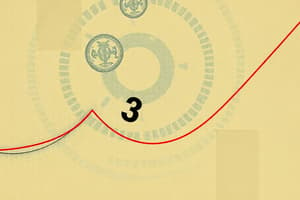Podcast
Questions and Answers
What does aggregate demand (AD) represent in an economy?
What does aggregate demand (AD) represent in an economy?
- The total supply of goods and services at different price levels
- The total money supply in an economy
- The total revenue of all businesses in a given period
- The total spending on domestic goods and services at different price levels (correct)
Which of the following is NOT a component of aggregate demand?
Which of the following is NOT a component of aggregate demand?
- Net exports (X - M)
- Government spending (G)
- Savings (S) (correct)
- Consumption (C)
Why is the aggregate demand curve downward sloping?
Why is the aggregate demand curve downward sloping?
- A higher price level reduces purchasing power and net exports (correct)
- A higher price level always leads to more demand
- A higher price level increases consumer purchasing power
- A higher price level reduces real wealth, increasing demand
What causes a movement along the AD curve rather than a shift?
What causes a movement along the AD curve rather than a shift?
Which of the following will cause a rightward shift in the AD curve?
Which of the following will cause a rightward shift in the AD curve?
What is the likely effect of a significant increase in business confidence?
What is the likely effect of a significant increase in business confidence?
Which of the following would shift AD to the left?
Which of the following would shift AD to the left?
If the domestic currency depreciates, how does it affect AD?
If the domestic currency depreciates, how does it affect AD?
How would a recession in a major trading partner country affect domestic AD?
How would a recession in a major trading partner country affect domestic AD?
If the central bank increases interest rates, what is the likely impact on AD?
If the central bank increases interest rates, what is the likely impact on AD?
If inflation in an economy rises significantly, how does it affect AD?
If inflation in an economy rises significantly, how does it affect AD?
Which policy would most effectively increase AD in a recession?
Which policy would most effectively increase AD in a recession?
If the government increases subsidies for businesses, what will likely happen to AD?
If the government increases subsidies for businesses, what will likely happen to AD?
Flashcards
Aggregate Demand (AD)
Aggregate Demand (AD)
Total spending on domestic goods and services at different price levels.
Components of AD
Components of AD
Consumption, Investment, Government Spending, and Net Exports.
Downward Sloping AD Curve
Downward Sloping AD Curve
AD curve slopes downward because higher price levels reduce purchasing power.
Movement along AD Curve
Movement along AD Curve
Signup and view all the flashcards
Shift in AD Curve
Shift in AD Curve
Signup and view all the flashcards
Consumption (C)
Consumption (C)
Signup and view all the flashcards
Government Spending (G)
Government Spending (G)
Signup and view all the flashcards
Net Exports (X-M)
Net Exports (X-M)
Signup and view all the flashcards
Impact of Lower Income Tax
Impact of Lower Income Tax
Signup and view all the flashcards
Effect of Increased Business Confidence
Effect of Increased Business Confidence
Signup and view all the flashcards
Impact of Government Spending Cuts
Impact of Government Spending Cuts
Signup and view all the flashcards
Effect of Currency Depreciation
Effect of Currency Depreciation
Signup and view all the flashcards
Recession Abroad
Recession Abroad
Signup and view all the flashcards
Rising Interest Rates
Rising Interest Rates
Signup and view all the flashcards
Effect of Higher Inflation
Effect of Higher Inflation
Signup and view all the flashcards
Increasing Government Subsidies
Increasing Government Subsidies
Signup and view all the flashcards
Impact of Lower Interest Rates
Impact of Lower Interest Rates
Signup and view all the flashcards
Consumer Confidence
Consumer Confidence
Signup and view all the flashcards
Investment (I)
Investment (I)
Signup and view all the flashcards
Impact of Government Regulations
Impact of Government Regulations
Signup and view all the flashcards
Foreign Income Effect
Foreign Income Effect
Signup and view all the flashcards
Expectations of Economic Growth
Expectations of Economic Growth
Signup and view all the flashcards
Effects of Automatic Stabilizers
Effects of Automatic Stabilizers
Signup and view all the flashcards
Current Economic Conditions
Current Economic Conditions
Signup and view all the flashcards
Role of Fiscal Policy in AD
Role of Fiscal Policy in AD
Signup and view all the flashcards
Monetary Policy Impact
Monetary Policy Impact
Signup and view all the flashcards
Study Notes
Aggregate Demand (AD) and the AD Curve
-
Definition of Aggregate Demand (AD): The total spending on domestic goods and services at different price levels in an economy.
-
Components of Aggregate Demand: Consumption (C), Government spending (G), Net exports (X-M). Savings (S) is not a component of AD.
-
Shape of the AD Curve: Downward sloping. A higher price level reduces purchasing power (decreasing consumption, investment, and net exports), leading to lower aggregate demand.
-
Movement vs. Shift along the AD Curve: A change in the price level causes a movement along the AD curve, while factors like consumer confidence, interest rates, and government spending cause a shift of the entire AD curve.
Causes of AD Shifts
-
Consumption (C): Lower income taxes increase disposable income, boosting consumption and shifting AD to the right. Conversely, an increase in interest rates or a fall in consumer confidence would reduce consumption and shift AD to the left.
-
Investment: Increased business confidence leads to more investment, shifting AD to the right.
-
Government Spending (G): Increased government spending shifts AD to the right, decreased government spending, shifts AD left.
-
Net Exports (X-M): A weaker domestic currency (depreciation) increases net exports (exports cheaper, imports more expensive), leading to a rightward shift in AD. A stronger currency decreases net exports (exports more expensive, imports cheaper), resulting in a leftward shift in AD. A recession in a major trading partner would decrease AD because of reduced demand for exports.
-
Interest Rates: Higher interest rates increase the cost of borrowing, reducing consumption and investment, shifting AD left. Lower rates encourage spending & investment which shifts AD right
Inflation's Effect on AD
- Inflation erodes real incomes, reducing consumption, and shifting AD to the left.
Policies to Increase AD
- Lowering interest rates and increasing government spending can effectively boost aggregate demand during a recession.
Studying That Suits You
Use AI to generate personalized quizzes and flashcards to suit your learning preferences.




